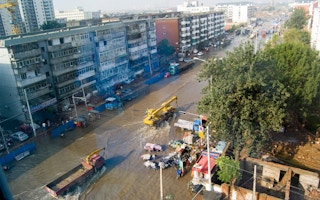Cities could reduce flooding by constructing sidewalks from an absorbent building material commonly used in household kitchens, scientists have discovered.
Sidewalks made from travertine - a form of limestone used for tiles and kitchen bench tops - can cut flooding by up to 50 per cent, according to a study by researchers at Xi’an Jiaotong-Liverpool University in Suzhou, southeast China.
As well as helping water escape into the ground, travertine removes a number of pollutants that occur when rainwater mixes with dirt, rendering it suitable for agriculture, they said.
“We have more evidence to show that flooding is happening more often all over the world due to climate change,” said Xiaonan Tang, a co-author of the study and associate professor at the university’s department of civil engineering.
“This new material helps reduce urban surface flow to reduce flooding,” he told the Thomson Reuters Foundation on Tuesday.
Over the past four decades, natural disasters have cost the Asia-Pacific region about $1.3 trillion, according to U.N. estimates, with China, the Philippines, Vietnam and Japan worst-hit by typhoons.
“
Travertine is a porous material with kind of sponge texture - it has many tiny holes in it - and those holes actually decrease its economic value in the current market.
Hamidreza Rahimi, researcher, Xi’an Jiaotong-Liverpool University
As the region’s population becomes more urban and the effects of climate change cause more extreme weather conditions, exposure to flooding is increasing, UN experts say.
Flood-prone cities such as Wuhan, in China, are increasingly testing new innovations to reduce risks. The metropolis has dubbed itself a “sponge city” and turned to water-absorbing asphalt, among other measures.
Travertine is cheaper than both water-absorbing asphalt and concrete, and is found in volcanic areas around the world, but it has yet to be tested to determine whether it is strong enough to be used for roads, the researchers said.
Traditional materials like concrete are not very absorbent, which exacerbates flooding, they said.
“Travertine is a porous material with kind of sponge texture - it has many tiny holes in it - and those holes actually decrease its economic value in the current market,” said Hamidreza Rahimi, the report’s lead author.
“In its holey form, it’s considered waste material as it needs to be smooth and hole-free when used in domestic building projects,” he said in a statement.
This story was published with permission from Thomson Reuters Foundation, the charitable arm of Thomson Reuters, that covers humanitarian news, women’s rights, trafficking, property rights, climate change and resilience. Visit http://news.trust.org)

















